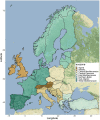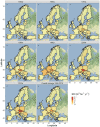Significant increase in natural disturbance impacts on European forests since 1950
- PMID: 36504289
- PMCID: PMC10107665
- DOI: 10.1111/gcb.16531
Significant increase in natural disturbance impacts on European forests since 1950
Abstract
Over the last decades, the natural disturbance is increasingly putting pressure on European forests. Shifts in disturbance regimes may compromise forest functioning and the continuous provisioning of ecosystem services to society, including their climate change mitigation potential. Although forests are central to many European policies, we lack the long-term empirical data needed for thoroughly understanding disturbance dynamics, modeling them, and developing adaptive management strategies. Here, we present a unique database of >170,000 records of ground-based natural disturbance observations in European forests from 1950 to 2019. Reported data confirm a significant increase in forest disturbance in 34 European countries, causing on an average of 43.8 million m3 of disturbed timber volume per year over the 70-year study period. This value is likely a conservative estimate due to under-reporting, especially of small-scale disturbances. We used machine learning techniques for assessing the magnitude of unreported disturbances, which are estimated to be between 8.6 and 18.3 million m3 /year. In the last 20 years, disturbances on average accounted for 16% of the mean annual harvest in Europe. Wind was the most important disturbance agent over the study period (46% of total damage), followed by fire (24%) and bark beetles (17%). Bark beetle disturbance doubled its share of the total damage in the last 20 years. Forest disturbances can profoundly impact ecosystem services (e.g., climate change mitigation), affect regional forest resource provisioning and consequently disrupt long-term management planning objectives and timber markets. We conclude that adaptation to changing disturbance regimes must be placed at the core of the European forest management and policy debate. Furthermore, a coherent and homogeneous monitoring system of natural disturbances is urgently needed in Europe, to better observe and respond to the ongoing changes in forest disturbance regimes.
Keywords: European forests; bark beetles; climate change; empirical disturbance data; fire; forest natural disturbances; windstorms.
© 2022 The Authors. Global Change Biology published by John Wiley & Sons Ltd.
Conflict of interest statement
All the authors declare no conflict of interest.
Figures






References
-
- Albrich, K. , Seidl, R. , Rammer, W. , & Thom, D. (2022). From sink to source: Changing climate and disturbance regimes could tip the 21st century carbon balance of an unmanaged mountain forest landscape. Forestry: An International Journal of Forest Research, cpac022. 10.1093/forestry/cpac022 - DOI
-
- Annila, E. (1969). Influence of temperature upon the development and voltinism of Ips typographus L. (Coleoptera, Scolytidae). In Annales Zoologici Fennici (pp. 161–208). Societas Biologica Fennica Vanamo.
-
- Baier, P. , Pennerstorfer, J. , & Schopf, A. (2007). PHENIPS—A comprehensive phenology model of Ips typographus (L.) (Col., Scolytinae) as a tool for hazard rating of bark beetle infestation. Forest Ecology and Management, 249, 171–186. 10.1016/j.foreco.2007.05.020 - DOI
-
- Brázdil, R. , Zahradník, P. , Szabó, P. , Chromá, K. , Dobrovolný, P. , Dolák, L. , Trnka, M. , Řehoř, J. , & Suchánková, S. (2022). Meteorological and climatological triggers of notable past and present bark beetle outbreaks in the Czech Republic. Climate of the Past, 18(9), 2155–2180. 10.5194/cp-2022-50 - DOI
-
- Breiman, L. (2001). Random forests. Machine Learning, 45(1), 5–32.
MeSH terms
Grants and funding
LinkOut - more resources
Full Text Sources

